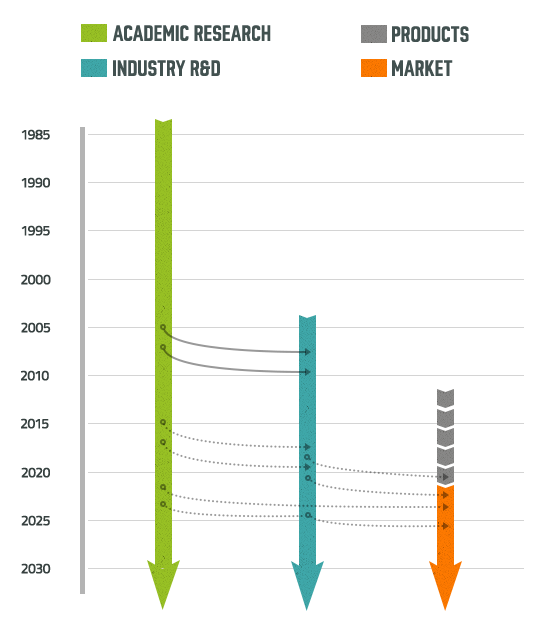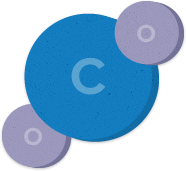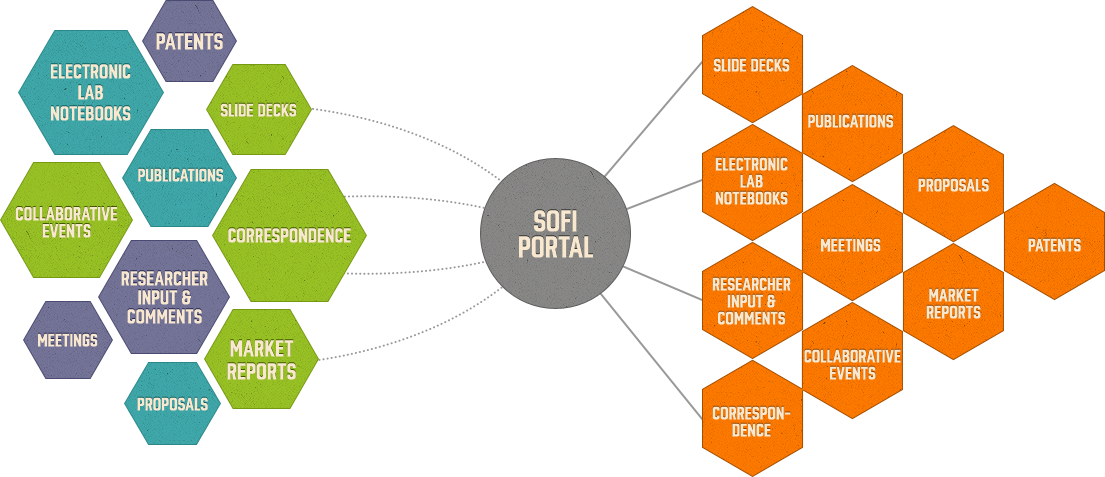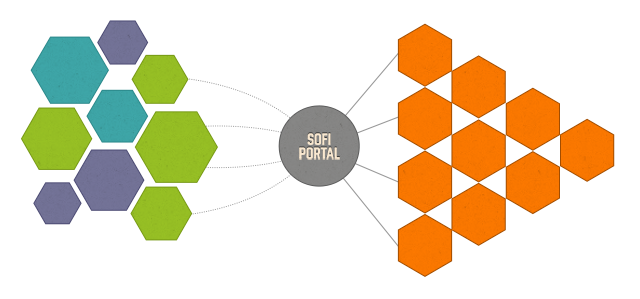Latest SOFI Collaborative Exchange Sees Partnership Between JCAP and University of Glasgow
SOFI’s Collaborative Exchanges represent a new way of sharing and developing research across institutions and across the world.
In the latest Exchange, work between SOFI member the Joint Center for Artificial Photosynthesis (JCAP) and Solar Fuels Network (SFN) member Mark Symes at the University of Glasgow will test several metal-chalcogenide proton reduction catalysts. JCAP will send its films to Symes’ research group, which will test their materials in a device to determine their long-term performance and develop strategies to minimize catalyst degradation. The Glasgow team has facilities to test device-scale electrodes over extended times and a range of temperatures and current densities. This exchange all began when Symes saw Fadl Saadi, graduate student at California Institute of Technology, speak at the SOFI/SFN workshop after the Gordon Conference. Saadi works in Nathan Lewis’ group and is part of JCAP. He was describing his catalysts, and mentioned that they hadn't really tried them at high current densities or for extended periods. “I thought, ‘That's something I bet we could do at Glasgow,’” Symes says. “So I went and spoke to him and agreed that they'd send us some samples and we'd try some things out.” Symes is excited about this collaboration for personal reasons, but also because of what can be learned. “I'm looking to raise my academic profile and it would be awesome to have a joint paper with the guys at JCAP,” he says. “It would also be interesting from a scientific point of view to see how these metal-chalcogenide catalysts hold up under some pretty harsh operating conditions.”
SOFI is creating a new paradigm in cross-institution collaborative research with our Collaborative Exchange program.
Part cultural exchange, part research opportunity, SOFI’s Collaborative Exchanges fund students to travel to foreign laboratories to learn new techniques and advance research projects in both institutions. It’s an unusual undertaking in the world of academic science, explains Dick Co, managing director of SOFI. “Besides cultural exchange, we’re also funding science that’s unique and high risk; that’s somewhere in between chemistry and engineering,” Co says. It’s not easy to get these kinds of projects funded, which is why this program is so important. “This is money for science that falls through the cracks.” Not only is it difficult to fund unique projects like the ones SOFI supports, but it’s also hard for international projects to find funding. Co explains that, generally, organizations like the Department of Energy prefer to fund only domestic projects. SOFI recognizes that the reality is, research centers across the world are working on solar fuels technology, and everyone benefits from sharing knowledge and learning. Scientists also benefit from getting to know one another and developing relationships across institutions. “The people element is important,” Co says. SOFI will continue to look for opportunities to fund innovative projects through their Collaborative Exchange program and share the progress of these partnerships with the wider community.
On June 11th – 13th SOFI will hold its annual meeting in Uppsala, Sweden.
SOFI members and prospective members will gather for roundtable discussions and presentations from the SOFI staff. About 25 participants are slated to attend from countries around the world, including Sweden, the UK, France, Germany, Korea, and the US. Topics on the agenda include developing incentives to help drive research and collaboration, increasing cross discipline interactions, economic impacts of Solar Fuels research, and moving beyond the lab bench to commercialize current Solar Fuels technologies. The meeting will be held at the Uppsala Konsert och Kongress (UKK), and architectural gem, which opened its doors in 2007. It “is a true juxtaposition to the rest of the architecture in Uppsala. The modern glass and metal cube sits on the east side of the river, opposite the Castle and Cathedral,” says SOFI’s Amanda Smeigh. This will be the first of SOFI’s annual meetings held outside the US, and Uppsala will make an excellent location. Attendees should be able to enjoy beautiful weather, outdoor dining, and a relaxed, walkable city. The SOFI team is looking forward to the meeting, and updating its members on its results.
What if we could harness our collective ingenuity
to solve our global energy challenge?
Artificial Photosynthesis for a Clean Energy Future
Academic research supported by SOFI will drive industry R&D and the creation of commercially-viable products.

THE PRODUCT
SOFI's goal is the development of efficient, cost effective photocatalytic systems that use the energy of sunlight to produce liquid fuels.

THE METHOD
SOFI will provide global research institutions with support and cutting edge opportunities for collaboration, fostering the next generation of solar fuels research to address the energy needs of the 21st century.


Small grey arrows indicate breakthroughs and milestones that positively influence adjacent fields.
SCIENCE BASED ON A MODEL PROVEN BY NATURE
By mimicking one of nature's most fundamental processes – photosynthesis – SOFI scientists and engineers aim to fuel the planet sustainably using the ultimate energy source: the sun. We’ll convert the sun's energy into clean fuels by following nature's photosynthetic blueprint.

LIGHT CAPTURE
Natural photosynthesis begins with the capture and absorption of sunlight. That light energy is then transported and used to split charges. The charges are further transferred to catalytic sites to perform the fuel forming reactions.
SOFI scientists aim to convert the sun’s energy into clean fuels by following nature’s photosynthetic blueprint. SOFI researchers are using a variety of state-of-the-art methods, such as molecular sensitizers, nanoarchitectures, organic dyes, semiconductors, and plasmonic devices, to enhance the capture and utilization of light energy. Scientists are developing artificial light-harvesting systems to span the entire spectrum that is useful for solar fuel production (400 nm − 1000 nm). They are implementing novel designs to efficiently transport the absorbed energy to artificial reaction centers that then separate the negative and positive charges. The photoinduced electron transfer events can then drive the various fuel forming reactions pursued by SOFI researchers.

WATER SPLITTING
All fuel-forming reactions and catalysis involve moving electrons from one species to another, a.k.a. redox chemistry (combination of “reduction” and “oxidation”).
In order to store the energy from the sun in the form of fuels, researchers will need a clean source of electrons. Nature’s source of electrons in photosynthesis comes from water. Electrons can be derived from the conversion of water molecules into their constituent oxygen gas and positive hydrogen ions (oxidation). This process, however, is very difficult, and requires special substances— catalysts— to facilitate that reaction. SOFI researchers are developing new catalysts that use earth-abundant elements to split water, either by an electrical potential or by a light-driven process.

CO2 CATALYSIS
Humans are emitting carbon dioxide (CO2) at an unprecedented rate by burning fossil fuels for transportation and electricity generation, which is driving global climate change.
Photosynthesis originally converted that CO2 into the organic matter, which, over millions of years, turned into the coal and oil we are extracting from the ground today. Recycling CO2 (obtained from flue gas from smokestacks or extracted from ambient air) to produce liquid fuels can provide near-term solutions that fit within the existing energy infrastructure and can mitigate the negative effects of dirty energy sources. Of particular interest is the reduction of CO2 to CO, which, as a component of synthesis gas (syngas), can be converted to methane, synthetic petroleum, or other liquid fuels using commercially mature technologies. SOFI researchers are developing new catalysts that waste less energy, are more efficient, and have greater longevity.

SUPPORTING MEMBERS

CORE MEMBERS

PROSPECTIVE MEMBERS
A GLOBAL NETWORK FOR GLOBAL CHANGE THROUGH
TEAM SCIENCE & COLLABORATIVE RESEARCH
Since February 2012, universities, government labs, academic institutions, private
corporations and non-profit organizations have come together to realize SOFI's vision.
Infrastructure Leasing & Financial Services Ltd., Mumbai, India
Uppsala University, Uppsala, Sweden
Northwestern University, Evanston, IL, USA
Total, Courbevoie, France
Korea Center for Artificial Photosynthesis, Seoul, Korea
CEA-Grenoble, Grenoble, France
Rutgers University, New Brunswick, NJ, USA
Pacific Northwest National Laboratory, Richland, WA, USA
Max Plank Institute for Chemical Energy Conversion, Muelheim, Germany
Joint Center for Artificial Photosynthesis (JCAP), Pasadena, CA, USA
Center for Bio-Inspired Solar Fuel Production (BISFuel), Phoenix, AZ, USA
Brookhaven National Laboratory, Brookhaven, NY, USA
Argonne National Laboratory, Lemont, IL, USA
UNC Solar Fuels EFRC, Chapel Hill, NC, USA
University of Pretoria, Pretoria, South Africa
Weizmann Institute of Science, Rehovot, Israel
Creating a Solar Fuels Knowledge Map to
Accelerate Discovery and Shorten Product Lead Time
The SOFI Knowledge Map will aggregate critical information and data using sophisticated modern tools to guide vision and planning of this industry beyond what current patent and publication frameworks can provide.


QUESTIONS
We acknowledge the complexity of such an undertaking and recognize the many technological, commercial, institutional, political and even behavioral hurdles to meaningful progress. Here are important questions we've addressed. Email us to ask your own.
WHAT WILL A SOLAR FUEL DEVICE LOOK LIKE?
Simple answer: we don’t really know yet. The eventual solar fuels device can range from a portable device that provides personalized power to a utility plant that operates on the multi-MW scale.
Imagine a unit that sits on the roof of a home and is driven by sunlight to convert water and ambient CO2 into a storable liquid fuel. Or imagine a factory that produces artificial aviation fuel while leaving no carbon footprint. The outcomes of this technological revolution will depend on the development of current science and the discovery of new materials and processes.
How is SOFI different from other science groups?
We are global, and we want to transform how academic research interfaces with the modern world. Solar fuel is a nascent technology today, and we believe government-funded academic labs
across the globe are in the best position to advance discoveries through translational research with industry input. To accomplish that, SOFI will use digital collaborative tools and electronic lab notebooks that incentivize the sharing of knowledge, transforming today’s publication-based academia (slide decks, blog posts, datasets, and software) into an organized, accessible database of information. It is also SOFI’s goal to capture and publish failed/null results so that they can be cited and accelerate progress.
Why haven't I heard about this before?
A solar fuel, a.k.a. artificial or industrial photosynthesis, is a complex and ambitious vision. It requires mastery of technical areas that are being developed today and many more that have yet to be discovered.
The U.S. Department of Energy has invested over $300 million in these efforts, while companies from ExxonMobil to Panasonic to Toyota and many international labs are actively pursuing different solar fuel pathways. Bypassing "archived sunlight" in fossil fuels, once a pipe dream, is rapidly becoming a reality. SOFI is here to raise awareness and shorten lead time.
What do members get from being a part of SOFI?
Members are the core of the SOFI initiative. Academic and Corporate Membership is by invitation (and do contact us to be invited). Membership fees support SOFI’s operations and provide seed funding
for translational research across academic, industry, and government labs. Members have access to the top experts in the field, to an interactive exchange of ideas across a wide spectrum of technologies (via the SOFI Knowledge Map), and to a dedicated SOFI management team positioned to identify opportunities for technology acceleration, expanded research revenue streams for SOFI-led projects, and advocacy.
What about other alternative energy sources?
There are a number of technology pathways being explored in the quest for sustainable energy— from wind to solar to biofuels to geothermal, each with its own set of advantages and disadvantages.
Ultimately, the solution will likely be the deployment of a portfolio of these technologies. The intermittency of wind and solar necessitates solutions for energy storage, and a liquid fuel packs significantly more energy per volume than batteries. This in turn lowers costs and facilitates wider adoption. Solar liquid fuels can also be easily adopted within the current energy infrastructure in transportation.
How will SOFI manage intellectual property?
SOFI believes that there are likely more failures to learn from than IP to fight over in solar fuels research today, hence the intense focus on pre-competitive sharing and building of a trusting network.
However, SOFI has crafted a set of guidelines for the management of IP that protects the interests of the inventing parties. The IP Management Guidelines are intended to promote a consistent, uniform, and simplified approach to the disposition of IP rights and the handling of proprietary and protected data across all SOFI Members to accelerate research via an open exchange of information.
PEOPLE
SOFI is driven by a team of industry pioneers, thought leaders, scientific visionaries, and expert researchers. We believe the stakes are high and the time is ripe to embrace innovative ways of addressing the energy challenge.
Milko van der Boom
Milko van der Boom
Weizmann Institute of Science
Ronny Neumann
Ronny Neumann
Weizmann Institute of Science
Gary Brudvig
Gary Brudvig
Yale University
Aaron Appel
Aaron Appel
Pacific Northwest National Laboratory
Morris Bullock
Morris Bullock
Pacific Northwest National Laboratory
Wolfgang Lubitz
Wolfgang Lubitz
Max Plack Institute for Chemical Energy Conversion
Vincent Artero
Vincent Artero
CEA-Grenoble
James Muckerman
James Muckerman
Brookhaven National Laboratory
Etsuko Fujita
Etsuko Fujita
Brookhaven National Laboratory
Ralph House
Ralph House
UNC-Chapel Hill
Will Royea
Will Royea
Joint Center for Artificial Photosynthesis
Ellen Stechel
Ellen Stechel
Arizona State University
Michael Wasielewski
Michael Wasielewski
Northwestern University
Charles Dismukes
Charles Dismukes
Rutgers University
Laura Fabris
Laura Fabris
Rutgers University
Leif Hammrstrom
Leif Hammrstrom
Uppsala University
Dunbar Birnie
Dunbar Birnie
Rutgers University
Devens Gust
Devens Gust
Arizona State University
Clare Hamilton Hall Professor of Chemistry; Director, Argonne-Northwestern Solar Energy Research (ANSER); Founding Member, Solar Fuels Institute (SOFI); Senior Scientist, Center for Nanoscale Materials, Argonne National Laboratory.
Mike oversees a range of energy research projects whose funding totals more than $25 million. His research focuses on light-driven charge transfer and transport in molecules and materials, photosynthesis, nanoscale materials for solar energy conversion, spin dynamics of multi-spin molecules, molecular materials for optoelectronics and spintronics, and time-resolved optical and electron paramagnetic resonance spectroscopy. Mike received both his B.S. and Ph.D. in Chemistry from the University of Chicago.
Camille & Henry Dreyfus Environmental Chemistry Mentor and Research Associate Professor of Chemistry at Argonne-Northwestern Solar Energy Research (ANSER) Center/Northwestern University; Founding Member, Solar Fuels Institute (SOFI).
Dick will supervise the successful development and implementation of SOFI’s Knowledge Map and collaborative tools for innovation in order to provide SOFI members with the resources and tools necessary to enhance collaboration and project management. Dick’s scholarly research focuses on the creation of better solutions for solar energy conversion through the study of how light and matter interact: Dick also employs femtosecond stimulated Raman spectroscopy and ultrafast transient absorption to investigate the charge transfer dynamics of photocatalysts and molecular constructs. Dick received his B.S. from the University of California, Berkeley, and his Ph.D. in Chemical Physics from Harvard University.
Founding Member, Solar Fuels Institute (SOFI); visiting scholar at Northwestern University. Kimberly is developing and structuring SOFI partnerships of strategic value with an emphasis on financial management, growth, and risk analysis.
Kimberly is managing partner in farming, oil and gas, entertainment, and banking enterprises. She served as Managing Director of a $1 billion multiple investment fund with partners JE Robert, GE Capital, and Goldman Sachs, and as Head of JE Robert's Dallas Corporate Office. She worked on the first teams for the Resolution Trust Corporation and the Federal Asset Disposition Association during the savings and loan crisis. Prior to that she was Manager of Finance at Rosewood Properties and Rosewood Venture Capital in Dallas, TX. Since moving to Telluride, CO, she has served as founding board member for five non-profits in education and the arts. Kimberly holds a BS from the University of Kansas and attended the Executive Education Program at the Tuck School of Business.
Founding Member, Solar Fuels Institute (SOFI); visiting scholar at Northwestern University. Jon’s primary focus is on government outreach.
Jon’s past positions include: Principal/Partner, Noribachi, an alternative technology firm based in Los Angeles; Vice President, Energy Risk Management, Goldman Sachs, Asia and Managing Director, Astra Oil Group based in Singapore and Zug, Switzerland. Jon has also served on several non-profit boards, including the United World College and the Santa Fe Preparatory School. He maintains a strong interest in organizational governance and the effective functioning of markets. Jon received his B.A. from the University of North Carolina at Chapel Hill and his M.A. in Public Policy from the Johns Hopkins University School of Advanced International Studies.
Program Manager, Solar Fuels Institute (SOFI). Amanda is an expert in solar cells and solar fuels, and is deeply passionate about solar energy’s potential to enhance our quality of life and decrease our dependence on fossil fuels.
Amanda works with Dick to further design and develop SOFI’s Knowledge Map and manage the collaborative Exchanges. She is motivated to work with SOFI’s members to expedite breakthroughs in their science and leverage resources to advance research toward attaining a liquid solar fuel. Amanda’s academic background is in ultrafast transient absorption spectroscopy and characterization of electron transfer processes in both n- and p-type dye-sensitized solar cells. Previously, she worked at Uppsala University / the Swedish Consortium for Artificial Photosynthesis and the Argonne-Northwestern Solar Energy Research (ANSER) Center at Northwestern. Amanda received her B.A. from the College of Wooster in 2001 and her Ph.D. in Chemistry from Michigan State University in 2007.
Amin Badr-El-Din is an expert in international affairs and one of Middle East’s leading economic and energy strategists. Amin founded and led BADR Investments, a global private investment firm that has a diversified portfolio of ventures spread across a range of industries and geographies.
Amin has created a fully integrated economic modeling and practical implementation plans for successful downstream economic growth for several countries, predominantly in the Middle East. Amin was also founder and Chairman/CEO of the UAE Offsets Group (the UOG) which pioneered a model unique amongst offsets operations in the world, including the creation of the strategic (US $8 billion) Dolphin gas initiative in the UAE. Dr Badr-El-Din has advised a number of governments including Ireland, France, Jordan, UAE, South Africa, Malaysia, Switzerland and Indonesia. He is a Fellow of the Royal Aeronautical Society, as well as a member of other professional organizations, and is involved in several non-profit activities. He took a First Class Honours degree in Electronic Engineering and Aerodynamics at the University of London, and holds a Ph.D. in Electrical Engineering at Stanford University
Sebastien de Halleux co-founded Playfish, one of the largest and fastest growing social game companies which disrupted the video game industry by changing how millions of people play together. Playfish was acquired by video game giant Electronic Arts in November of 2009.
Prior to starting Playfish, Sebastien assisted in the launch of Macrospace, and early pioneer in mobile games (now Glu Mobile, which IPOed in 2007) and worked at other companies including Nokia and Booz Allen Hamilton. He holds a master's degree in Civil Engineering from Imperial College London. Sebastien is an active angel investor and is involved in several non-profit projects which harness bright minds and technology to change the world for good. Sebastien was a recipient of the 2010 TechFellow Award. He has resided in Brussels, Bangkok and London, and presently lives in San Francisco.
Jay Walsh began his service as Northwestern University's Vice President for Research in 2007 and was formerly the senior associate dean of McCormick School of Engineering and Applied Sciences, where he is a professor of biomedical engineering.
Jay received a bachelor's and master's degree in electrical engineering from Massachusetts Institute of Technology. Immediately following receipt of his Ph.D. in medical engineering from Harvard Medical School and MIT, Jay joined the Northwestern faculty in 1988. Walsh's early research on laser-tissue interactions helped frame the understanding of laser ablation; this work formed the scientific foundation for now standard laser-based procedures in medicine and surgery. In the past decade, his research has focused on dignostic and therapeutic applications of light.
Joan Woodard served at Sandia for more than 35 years, including ten years as an Executive Vice President and Deputy Laboratory Director.
During her career at Sandia she held executive leadership positions in all of the mission programs at Sandia, including the nuclear weapons, nonproliferation, military technology and systems, energy, environment and waste management technology, and intelligence, as well as serving as chief operating officer responsible for all operating areas of the laboratories. She holds a Ph.D. in Mechanical Engineering from the University of California, Berkeley; an M.S. in Engineering Economic Systems from Stanford University; and a B.S. in Applied Mathematics and Computer Science from the University of Missouri-Rolla (magna cum laude). She has served on the Air Force Scientific Advisory Board (AF/ SAB), and the Congressional Commission to Assess the Vulnerabilities of the US Infrastructure to Electromagnetic Pulse. She also served on the National Academy of Science Study on Science and Technology for Countering Terrorism.
Anousheh Ansari is a serial entrepreneur, and prior to founding Prodea Systems, she served as co-founder, CEO and chairman of Telecom Technologies, Inc.
To help drive commercialization of the space industry, Anousheh and her family provided title sponsorship for the Ansari X Prize, a $10 million cash award for the first non-governmental organization to launch a reusable manned spacecraft into space twice within two weeks. Anousheh is a member of the X Prize Foundation’s Vision Circle, as well as its Board of Trustees. She is a life member in the Association of Space Explorers and on the advisory board of the Teacher’s in Space project. She currently works to enable social entrepreneurs to bring about radical change globally, with organizations such as X Prize, ASHOKA and the PARSA Community Foundation. She earned a bachelor’s degree in electronics and computer engineering from George Mason University and a master’s degree in electrical engineering from George Washington University.














